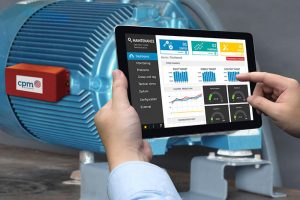Everything You Need to Know About CPM Engineering Smart Sensors
What is predictive maintenance?
Predictive maintenance is more or less what it says, it is a systematic method which helps determine the condition of in-service equipment in order to predict when maintenance should be performed.
What are Smart Sensors?
As the cost of sensors tumble it now makes continual monitoring of machines affordable with all the benefits of early warning failures. Smart Sensors stem from the industrial revolution 4.0 (IOT), as they manage data from electric motors, pumps and even slower moving equipment, the data is monitored and in turn can generate maintenance and production strategies that can maximize production yield. They can be retrofitted to any LV motor across all OEM’s including older models.
Smart Sensors detect developing faults in your electric motors, pumps etc by sensing vibration, speed and temperature parameters before they become detrimental to your production cycle. Analysed by an expert team who can then advise you on how and maintenance is required allowing you to maximise the output of your production plant and minimise maintenance costs.

How Do Smart Sensors Work?
When fitted to a rotating machine they can complement or replace the manual monitoring techniques which have been around for many years. Manual programmes, whereby an engineer applies a probe or reads from a fixed monitoring point is based on ‘routes’. The vibration, temperature, speed of the machine is recorded, perhaps once a month or quarter owing to the expense, while Smart Sensors record the condition every minute giving almost ‘live data’ on which to base maintenance decisions. This is key to a successful predictive maintenance strategy.
4 simple steps for Smart Sensors to work:
- Install the sensor
- Collect the data via Bluetooth or wireless gateway
- Interpret the data using extensive specially developed algorithms and
- Indicate the corrective actions required before the machine breaks down
What exactly do Smart Motors monitor?
They monitor:
- Energy consumption
- Vibration levels
- Temperature
- Operating hours
- Speed
Through this monitoring of the machine’s variables, we know, at all times, the condition of the machine.
In particular we know the condition of the:
- Electricity supply to the motor
- Stator
- Rotor
- Bearings
- Shafts
- Transmission systems
- Geometric eccentricities
- Power system of the motor
- Motor driven- load
This informs you when and why a maintenance operation needs to be carried out.

What kind of problems can Smart Sensors early detect?
- Defects in the power supply
- Problems in the drive system of the machine
- Insulation faults in the stator winding
- Rotor bars with manufacturing defects
- Broken short circuit rings
- Bearing currents
- Defects, in the cage, or rolling element bearing
- Geometric deformations in the stator or the rotor
- Deformations in the rotor shaft
- Defects in transmission systems and gearboxes
- Manufacturing defects of the machine
- Problems associated with the load driven by the electric motor (pump, compressor, fan …)
What Do Smart Sensors Deliver?
- Significantly reduced maintenance costs
- Harvest the data
- Advise of changes to machine conditions
- Continually monitor conditions and compare data with other similar machines
- Develop Machine Learning protocols
- Develop MTBF & Root Cause failure strategies
- Advise on Repair, Replace, Maintenance remedies
CPM will invest in our customers plant by supplying and installing the sensors and encompassing the ‘CPM Offer’ as part of a fixed-term agreement. CPM enter into a ‘risk and reward agreement’ whereby CPM pay for all repairs for a fixed monthly fee.
If Smart Sensor technology interests you, contact CPM today to discuss your individual needs.
